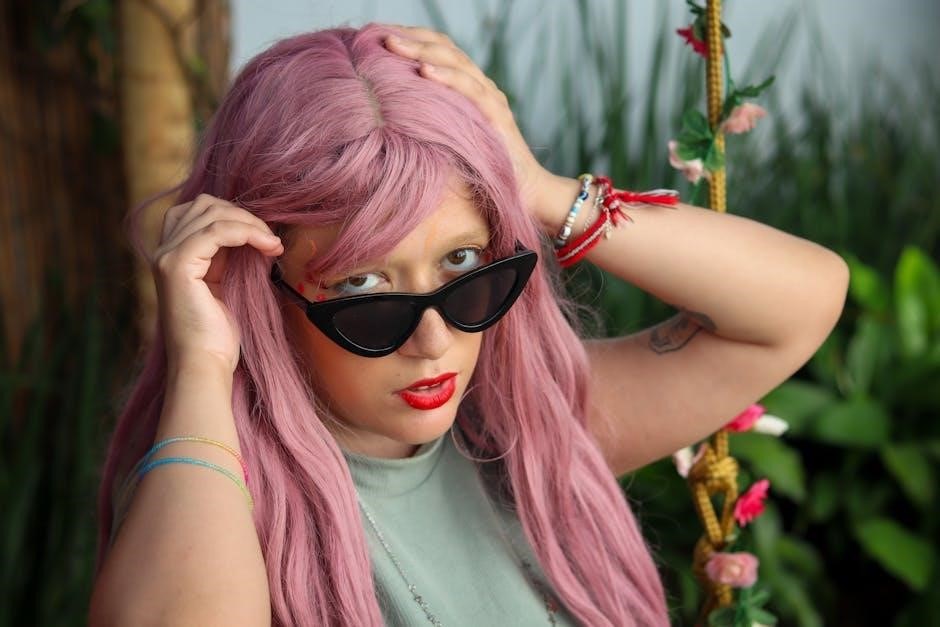
guido look
The Guido Look refers to a distinctive style and subculture associated with Italian-American communities, particularly in urban areas. Originating from New Jersey and New York, it blends flashy fashion, meticulous grooming, and a vibrant lifestyle. The term often carries both pride and controversy, reflecting stereotypes while celebrating cultural identity. This look is characterized by bold aesthetics, from tailored suits to specific hairstyles, and has been popularized by media portrayals, sparking debates about its representation and cultural significance.
1.1 Definition and Cultural Context
The Guido Look is a subcultural aesthetic and lifestyle primarily associated with Italian-American communities, particularly in urban areas like New Jersey and New York. It embodies a distinct style characterized by bold fashion, meticulous grooming, and a vibrant, often flamboyant attitude. The term “Guido” originates from Italian-American slang and has evolved into a complex cultural identifier. While it is celebrated as a symbol of pride and heritage by some, it is also criticized for perpetuating stereotypes. The Guido Look reflects a blend of traditional Italian influences and modern urban trends, creating a unique cultural phenomenon that sparks both admiration and controversy.
1.2 Historical Background
The Guido Look has its roots in Italian-American culture, emerging prominently in urban areas like New York and New Jersey during the mid-20th century. It reflects the cultural identity of working-class Italian-Americans, blending traditional influences with modern urban styles. The term “Guido” itself has debated origins, often linked to Italian names or slang, and has evolved into a subcultural identifier. Historically, the look was shaped by a mix of European heritage and American urban trends, creating a unique aesthetic that became synonymous with a specific demographic. Over time, it has both celebrated and faced criticism for its cultural expression, embodying a complex blend of pride and stereotype.
Key Elements of the Guido Look
The Guido Look is defined by flashy fashion, meticulous grooming, and bold accessories. It often features tailored suits, styled hairstyles, and eye-catching jewelry, embodying a vibrant, attention-grabbing aesthetic.
2.1 Fashion and Style
The Guido Look is synonymous with bold, flashy fashion. It often features tailored suits, typically in vibrant colors or patterns, paired with fitted dress shirts and sleek accessories. The style emphasizes a polished, attention-grabbing aesthetic, with a focus on brand-name clothing like Ed Hardy or Affliction. Flashy jewelry, such as chunky chains and bracelets, complements the outfit, creating a look that is both ostentatious and cohesive. The Guido style also includes a preference for tight-fitting clothing, accentuating a muscular physique, which is often associated with gym culture. This fashion sense reflects a blend of Italian-American identity, urban flair, and a desire to stand out in social settings.
2.2 Grooming and Hairstyles
Grooming is a cornerstone of the Guido Look, emphasizing a polished, well-maintained appearance. Hairstyles often feature a “blowout” or “pompadour,” styled with gel or mousse for a sleek, voluminous look. Facial hair is meticulously trimmed, with popular styles like the “Chinstrap” or “Soul Patch.” Skin care is also prioritized, with a focus on achieving a tanned, radiant complexion. The overall aesthetic is one of deliberate, attention-grabbing grooming, reflecting both cultural pride and a desire to stand out. This meticulous approach to personal appearance is deeply ingrained in the Guido identity, blending tradition with modern trends to create a distinctive, recognizable style.
2.3 Accessories and Jewelry
Accessories and jewelry are essential components of the Guido Look, often serving as bold statements of style and identity. Gold chains, crucifixes, and wristwatches are popular, symbolizing both cultural pride and a flashy aesthetic. Sunglasses, particularly aviator styles, are worn frequently, even indoors, to enhance the iconic look. Hats, such as fedoras or fitted caps, and belts with decorative buckles also complement the outfit. Rings, especially pinky rings, are common, often bearing sentimental or cultural significance; These accessories are carefully chosen to enhance the overall polished, attention-grabbing appearance, reflecting a blend of tradition and modern flair that defines the Guido style.

Cultural Significance and Stereotypes
The Guido Look embodies a blend of cultural pride and controversy, often stereotyping Italian-Americans as flashy and overly groomed. It reflects identity, tradition, and modern influences, sparking debates.
3.1 Media Portrayal and Controversies

The Guido Look has been heavily scrutinized and sensationalized by media, particularly through reality TV shows like Jersey Shore, which amplified stereotypes of Italian-Americans as flashy, tanned, and overly groomed. This portrayal sparked outrage in the Italian-American community, with many accusing the show of perpetuating negative and inaccurate representations. The term “Guido” itself has become a controversial label, often used as a derogatory slur. Media depictions frequently focus on exaggerated aesthetics and behaviors, reinforcing stereotypes that overshadow the cultural richness and diversity of Italian-American identity. This has led to ongoing debates about cultural sensitivity and the impact of such portrayals on public perception.
3.2 Impact on Italian-American Identity
The Guido Look has had a dual impact on Italian-American identity, fostering both cultural pride and controversy. While it celebrates aspects of Italian heritage through distinctive fashion and grooming, it also perpetuates stereotypes that simplify and reduce the complexity of Italian-American culture. The term “Guido” has become a polarizing label, often criticized for its association with caricatured portrayals in media. For some, it symbolizes a vibrant, unapologetic expression of identity, while for others, it reinforces negative perceptions. This duality has sparked debates about cultural representation, with many advocating for a more nuanced understanding of Italian-American experiences beyond the Guido stereotype.

Modern Interpretations
The Guido Look has evolved, blending bold fashion with contemporary trends, influencing modern style while maintaining its distinctive flair and cultural roots in Italian-American identity.
4.1 Evolution of the Guido Aesthetic
The Guido Look has transitioned from its origins in 1990s urban Italian-American culture to a more refined, modern style. While it retains its bold, flashy essence, it now incorporates contemporary fashion trends, blending sleek designs with classic elements. The aesthetic has evolved to include tailored fits, versatile color palettes, and a mix of casual and formal wear. Media influence, such as reality TV shows, has amplified its visibility, transforming it into a recognizable subculture. Despite its evolution, the Guido Look remains deeply rooted in its cultural heritage, symbolizing both pride and controversy in its representation of Italian-American identity.
4.2 Influences on Contemporary Fashion
The Guido Look has left a noticeable mark on contemporary fashion, inspiring bold and flashy styles. Its influence is seen in the resurgence of tailored suits, gold jewelry, and sleek hairstyles. Designers often draw from its vibrant aesthetic, incorporating elements like patterned shirts and precision-cut clothing into modern collections. The subculture’s emphasis on meticulous grooming and accessories has also shaped current trends, with high-fashion brands adopting similar confident, eye-catching approaches. While the Guido Look remains deeply rooted in Italian-American culture, its fusion with mainstream fashion has created a unique, recognizable style that continues to evolve and attract a diverse audience worldwide.
Lifestyle and Behavior
The Guido lifestyle emphasizes strong social bonds, family ties, and a vibrant nightlife. It often includes a passion for music, cars, and communal gatherings, reflecting a dynamic, expressive culture.
5.1 Social and Community Aspects

The Guido Look is deeply rooted in community and kinship, often emphasizing strong social bonds within Italian-American circles. Social dynamics revolve around loyalty, camaraderie, and shared cultural pride. Community gatherings, family celebrations, and cultural events play a central role, fostering a sense of belonging. The subculture thrives on collective identity, with individuals often connecting through shared traditions, music, and fashion. Local hangouts and communal spaces further strengthen these ties, creating a vibrant, interconnected social network. While the Guido subculture is sometimes stereotyped, its community-driven ethos reflects a resilient and proud cultural heritage.
5.2 Leisure Activities and Interests
Leisure activities for those embracing the Guido Look often revolve around fitness, nightlife, and socializing. Working out at the gym is a popular pastime, emphasizing physical appearance and strength. Clubbing and parties are central to the subculture, with a focus on dressing up and enjoying music. Car culture is another interest, with many taking pride in customized vehicles. Music preferences lean toward genres like house or Italian music. Sports, particularly those popular in Italian-American communities, also hold a significant place. These activities not only serve as hobbies but also reinforce social bonds and cultural identity, making leisure a vital part of the Guido lifestyle.
FAQs and Misconceptions
The Guido Look is often misunderstood as merely a fashion trend, but it encompasses cultural heritage and community identity, challenging stereotypes while sparking curiosity and debate.
6.1 Common Questions About the Guido Look
Common questions about the Guido Look often revolve around its origins, cultural significance, and stereotypes. Many wonder if it’s solely about fashion or a deeper identity. The Guido Look, rooted in Italian-American urban culture, blends bold style, grooming, and lifestyle. Questions arise about its association with reality TV shows like Jersey Shore, which popularized the term. Others inquire about its authenticity, asking if it’s a caricature or a genuine cultural expression. Additionally, there’s curiosity about its evolution and whether it’s embraced or rejected by the Italian-American community. These questions highlight the complexity of the Guido Look, blending fashion, culture, and controversy.
6.2 Debunking Stereotypes
The Guido Look is often misunderstood, with stereotypes portraying it as overly flashy or superficial. While the style is bold, it stems from a cultural pride rooted in Italian-American heritage. Critics argue it’s a caricature, but supporters see it as a celebration of identity. The media, particularly reality TV, has exaggerated certain traits, fostering misconceptions. Not everyone fits the stereotypical “Guido” image, as the subculture encompasses a broader range of expressions; Debunking stereotypes involves recognizing the diversity within the Guido community and understanding its historical and cultural context. It’s more than just a look—it’s a form of self-expression and cultural pride, often misrepresented in popular media.
The Guido Look is a vibrant subculture blending style, identity, and community, evolving over time while sparking debates about its cultural significance and representation in media.
7.1 The Enduring Appeal of the Guido Look
The Guido Look’s enduring appeal lies in its unique blend of cultural identity, self-expression, and community pride. Rooted in Italian-American heritage, it has evolved into a recognizable style that transcends fashion, embracing a distinct grooming aesthetic and a vibrant lifestyle. Despite controversies and stereotypes, the Guido Look remains a symbol of resilience and cultural pride. Its bold, flashy elements have captivated media attention, while its authenticity resonates with those who embrace their roots. The subculture’s ability to adapt while staying true to its origins ensures its lasting relevance in modern society, making it a fascinating subject of both admiration and debate.
7.2 Future of the Guido Subculture
The Guido subculture’s future likely lies in its ability to evolve while preserving its cultural roots. As fashion trends shift, the Guido Look may incorporate modern styles while maintaining its iconic elements, such as bold aesthetics and meticulous grooming. Younger generations may reinterpret the subculture, blending it with contemporary influences to create a fresh yet authentic identity. Media representation will play a crucial role in shaping its perception, with a potential shift toward more nuanced portrayals. The Guido subculture could expand beyond its Italian-American origins, influencing global fashion and fostering a broader sense of community. Its resilience and adaptability suggest a vibrant, enduring legacy.
Related Posts

hsr apocalyptic shadow guide
Uncover expert strategies in the HSR Apocalyptic Shadow Guide. Discover essential survival tips, gear recommendations, and tactics to thrive in any scenario.

antenna tv guide tulsa ok
Find the best free TV channels in Tulsa with our antenna TV guide. Get local stations, sports, news, and more without cable!

mcmasters guide to homicide
McMaster’s Guide to Homicide provides cutting-edge strategies to help you solve even the most challenging crimes. Elevate your investigation skills with expert techniques.